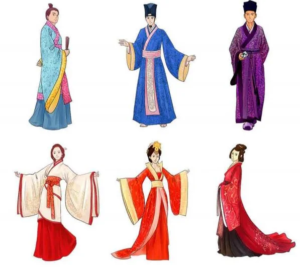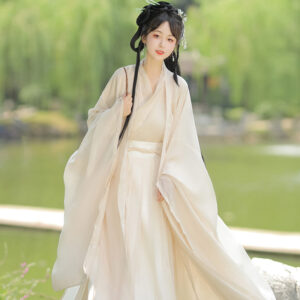

The Han Dynasty (206 BC – 220 AD) is renowned for its elegant and culturally rich Hanfu, which often featured a variety of intricate patterns. These designs were not merely decorative; they carried deep symbolic meanings and reflected the social norms and philosophical beliefs of the time. Here are some of the most common patterns found in Han Dynasty Hanfu:
1. Dragons
- Symbolism: The dragon is a powerful symbol in Chinese culture, representing imperial authority, strength, and good fortune. In Hanfu, dragon motifs were often reserved for the emperor and his family, signifying their supreme status.
2. Phoenixes
- Cultural Significance: The phoenix symbolizes grace, virtue, and harmony. Often paired with dragons, it represents the empress and embodies the ideal of a harmonious marriage between yin (female) and yang (male).
3. Floral Patterns
- Lotus Flowers: Representing purity and enlightenment, lotus motifs were popular in Hanfu designs. They conveyed messages of spiritual integrity and moral elevation.
- Peonies: Known as the “king of flowers,” peonies symbolize wealth, honor, and high social status. Their presence in patterns indicated the wearer’s aspirations or achievements.
4. Geometric Designs
- Checks and Stripes: Simple geometric patterns provided balance and symmetry to Hanfu designs. They often symbolized order and stability within society.
5. Natural Elements
- Clouds and Waves: These motifs were commonly used to represent auspiciousness and good fortune. They added a dynamic quality to the garments.
6. Cultural Influences
- The Han Dynasty was a period of extensive trade along the Silk Road, which introduced exotic motifs from Central Asia and beyond. This cultural exchange enriched Hanfu patterns with diverse floral and geometric designs.
Table: Common Patterns in Han Dynasty Hanfu
| Pattern Type | Description |
|---|---|
| Dragons | Symbol of imperial authority; reserved for royalty |
| Phoenixes | Represents grace and virtue; often associated with the empress |
| Lotus Flowers | Symbolizes purity and enlightenment; conveys spiritual integrity |
| Peonies | Represents wealth, honor, and high status; indicates aspirations |
| Geometric Designs | Includes checks and stripes; symbolizes order and stability |
| Natural Elements | Motifs like clouds and waves represent auspiciousness |
Conclusion
The patterns found in Han Dynasty Hanfu reflect a rich tapestry of cultural significance, aesthetic beauty, and social hierarchy. Each design element was carefully chosen to convey deeper meanings, making these garments not just clothing but also expressions of identity and values during one of China’s most influential historical periods.
Share this post
Recent Posts


What were the key features of Hanfu during the Tang Dynasty?

How did Hanfu styles vary during different Chinese dynasties?

What accessories are typically worn with Hanfu?

How do you choose the right Hanfu for different seasons?

Newsletter
Popular Categories
Related Post
Sed aliquam, tortor et sodales malesuada, lorem leo luctus tellus, quis interdum eros nibh in nunc. Cras dignissim malesuada, lorem leo luctus

What are the winter hanfu called?

What were the key features of Hanfu during the Tang Dynasty?

How did Hanfu styles vary during different Chinese dynasties?


